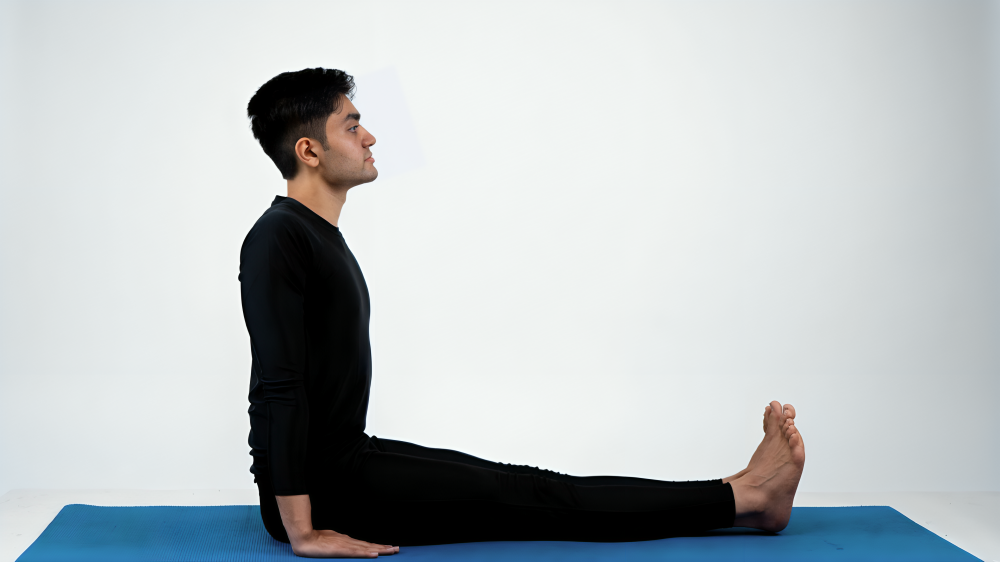
What Is Dandasana?
Dandasana comes from the Sanskrit words “Danda,” meaning “staff,” and “Asana,” meaning “pose.” The “staff” represents your spine, which should be straight and strong, just like a staff. Though it looks simple, it requires significant engagement of your core, legs, and back muscles to maintain proper alignment.
How to Do Dandasana: Step-by-Step Instructions
Find Your Seat: Start by sitting on the floor with your legs extended straight in front of you. Your feet should be flexed, with toes pointing toward the ceiling.
Align Your Spine: Sit up tall, making sure your spine is straight and perpendicular to the floor. Imagine a string pulling the crown of your head upwards.
Engage Your Core: Pull your belly button in toward your spine to engage your core muscles. This engagement helps to support your lower back.
Place Your Hands: Position your hands on the floor beside your hips with your fingers pointing toward your toes. Your arms should be straight but not locked.
Relax Your Shoulders: Drop your shoulders away from your ears, creating space in your neck. Avoid rounding your shoulders forward.
Gaze Forward: Keep your gaze straight ahead at eye level, maintaining a soft focus.
Hold the Pose: Stay in Dandasana for 30 seconds to a minute, breathing deeply and evenly.
Pro Tip: If your hamstrings or lower back feel tight, you can sit on a folded blanket or yoga block to elevate your hips slightly. This adjustment helps maintain the integrity of your spine without compromising the posture.
The Benefits of Practicing Dandasana
Improves Posture
Since Dandasana focuses on proper spinal alignment, it encourages good posture habits. Regular practice can help counteract the effects of sitting for long periods and alleviate back pain caused by poor posture.
Strengthens the Core and Back Muscles
Holding this pose requires engaging the core and back muscles, which can help strengthen these areas over time. A strong core is essential for stability in more advanced yoga poses.
Enhances Flexibility in the Legs and Hips
By maintaining an active leg position, Dandasana stretches the hamstrings and calves, helping to increase flexibility in these muscles. This stretch is particularly beneficial for those who experience tightness in the lower body.
Increases Body Awareness
Dandasana requires attention to detail and mindfulness in maintaining alignment. This increased body awareness can improve your overall yoga practice and help you notice and correct postural imbalances.
Prepares You for Other Poses
Dandasana serves as a foundational posture that helps prepare your body for more complex seated poses and forward bends. Mastering this pose can make transitions into other poses smoother and more effective.
Calms the Mind
Like many yoga poses, Dandasana has a calming effect on the mind. Focusing on your breath and maintaining the pose can help reduce stress and promote a sense of peace and tranquility.
It’s here Natarajasana how do it and what are the benefits
FAQs
Q1: Can beginners practice Dandasana?
Absolutely! Dandasana is suitable for all levels. Beginners should focus on proper alignment and may use props like blankets or blocks for support.
Q2: How long should I hold Dandasana?
Start with 30 seconds to a minute and gradually increase the time as you build strength and endurance.
Q3: What if I have tight hamstrings?
If your hamstrings are tight, sit on a folded blanket or yoga block to lift your hips slightly. This adjustment can help maintain a straight spine without straining your lower back.
Q4: Can Dandasana help with back pain?
Yes, practicing Dandasana with proper alignment can help alleviate back pain by improving posture and strengthening the core and back muscles.
Q5: Is it okay to bend the knees in Dandasana?
Yes, it’s fine to keep a slight bend in your knees if you find it difficult to straighten them fully. The goal is to maintain proper alignment and avoid straining.

